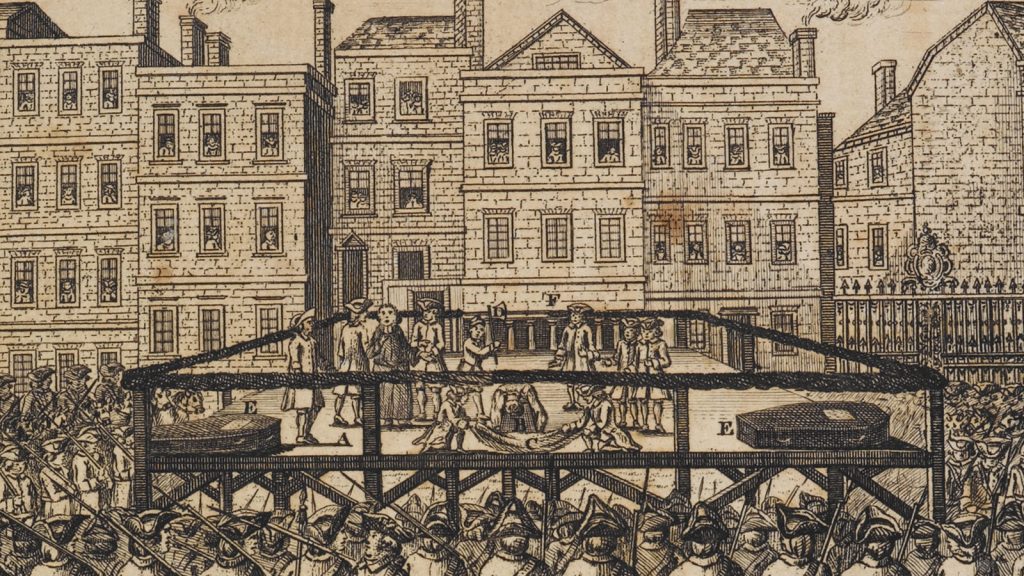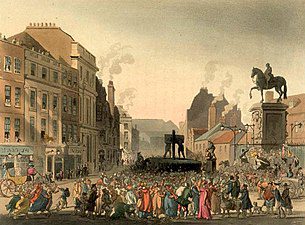**Note: In the United Kingdom, the Regency is a sub-period of the Georgian era (1714-1830) and runs from 1811 to 1820. It is named after the Prince of Wales who, as Prince Regent, took over rule from his ill father, George III, during this time. For the purpose of this article, we consider the Regency era to be from 1800 to 1830, and look at a few things about the time’s justice system.
If you are anything like me- and I sincerely hope you are ’cause that’s gonna make me feel a little less like a weirdo- you do enjoy a cup of coffee along with a suspenseful crime story.
Let’s just admit it- most people thrive on suspenseful stories. Personally, I’ve always had a fascination with crime stories. As morbid as that sounds, my guess is so have you, and so does the rest of the population because the proof is in the pudding. The old newsroom saying “if it bleeds, it leads” is still a mantra and ratings show that if the story is about a fire, accident, or murder –especially murder- the story is usually the most popular one.

I think my reason for feeling drawn to these stories is the same reason for most: we simply cannot wrap our minds around these crimes. We try to think like the criminal, we try to rationalize why a human being would act in such an unfathomable way against another human. But the truth is, no matter how much we research and study these individuals, we will never get a true insight to the inner workings of their usually warped psyche.
We get bits and pieces; we attribute terrible actions to childhood trauma, to untreated mental illness, and sometimes, even bad timing. But we can never truly pinpoint the exact reason why a human snapped. And that fact alone simply boggles our minds.
Trust me when I say that I can go on and on and on and on-well, you get the picture- about this subject, but for now let us get down to the matter at hand: Regency Era crime and punishment.
Crime rates during the Regency Era were relatively low. One might find that strange considering the hardships people of no noble birth had to live through, but the truth is, the people of the early 19th century England lead considerably calm lives, especially when compared to previous times.
When crimes were indeed committed, there were three types of courts:
Magistrate Courts (or justices of the peace) involved people from the local community who were not required to hold any legal qualifications and were responsible for both administering and maintaining the law at county level until 1888, when their administrative power was drastically undermined and taken away.
The principal courts of the Magistrates were Quarter Sessions, which were held four times a year before a bench of magistrates and a jury.

Petty Sessions were introduced later in the 18th century when it became apparent that the four-times-a-year operating system of the Quarter Sessions Court was not enough. Each court had jurisdiction over a specific local authority area and was held before at least two magistrates. They mostly dealt with minor offenses and the recording of new laws.
Assize Courts survived up to the mid 20th century and tried the most serious crimes, including capital offenses. Before 1842, the lines between Quarter Sessions and Assize Courts were rather blurred, with the former often referring serious or difficult cases to the Assize Courts.
The third type of Court in early 19th century England was the King’s Bench. It was the King’s personal court and its main responsibility was to protect the interests of the Crown. There are documented cases that were referred to the King’s Bench, but that only happened when impartial local ruling of the case was considered impossible or compromised.
The system described above was drastically altered in the mid 20th century.
In the early 19th century, the way courts operated was vastly different from today. Court conditions and the treatment of both the victim and the accused were very different, sometimes strange compared to what we now know as the judicial system.
Trials in courts were often very quick, closing in record time cases that would have taken moths to resolve in modern days (bureaucracy, yay!). And while jurors, judges and prosecutors have always been associated with social status, they held remarkably more power back then.
The prosecutor was normally the victim of the crime and the defendant was responsible for explaining away the evidence in their favor while at the same time undermining the prosecutor’s credibility.
And now, I want you to picture a trial where the defendant is accused of stealing the prosecutor’s hen. And trying to convince a jury about the psychological trauma the hen went through.
Oh come on, that’s funny!
If you didn’t laugh, you have no soul…
Hanging was a common punishment and at the same time the most severe, reserved for serious offenses and could only be ordered by the Assizes Court. That is not to say that this punishment was always justly carried out. There are many recorded cases of pick-pocketing and stealing food that were punished with death. Considering poverty rates were very high back then, these types of crimes were usually committed by everyday people in desperate situations. Towards the end of the 1700s, the execution of people for such petty crimes was causing public unrest (duh!).
This growing aversion towards capital punishment became more apparent later on, during the early 19th century, when the death of the prisoner was often recorded but never carried out, and the sentence changed to transportation or imprisonment. This practice lead to the decrease of the number of criminals sentenced to be hanged as the century went on.

I don’t know about you people, between a fashionable choker and the hangman’s rope, I’d rather wear the choker.
Or pearls! Oh, I like pearls…
Gaols in Regency England were harsh environments that developed systems of mass incarcerations, more often than not including hard labor, rooms of solitary confinement, silence and inadequate medical services.
Ah, heaven on Earth….(hello there, my name is ‘Sarcasm’, nice to meet you!)
While the initial idea was to use these prisons as less strict alternatives to execution and other forms of corporal punishment, gaols soon turned into harsh, terrifying places with two distinct missions: to deter people from committing crimes, but also to rehabilitate the inmates and lead them to moral reform.

A range of other punishments were, however, also frequently imposed.
In order to avoid the gallows, many felons were transported to the American colonies and later in the century, to those in Australia, where they served out their sentences in hard labor. Any criminal with a sentence of 7 years or longer could be transported, sometimes for life.
Though if you ask me, being sent to Australia was enough of a punishment on its own. Have you seen the spiders there?!
Other criminals convicted of lesser crimes were fined, though this was not commonly used as punishment. Most people were too poor and unable to pay.
Oh, the irony of punishing a poor farmer for pick-pocketing…by asking him to pay more money!
The most common physical punishments were usually accompanied by the element of public shaming, mostly in the form of being whipped ‘at the cart’s tail’, for example or being set in the pillory and pelted with rotten eggs and vegetables. Also, there are documented cases of people being branded on the hand by hot iron (Ouch!).

Over the course of the 18th century and by the time the 19th century rolled around, these practices had been mostly abolished, though whipping still somewhat persisted.
The number of public whippings drastically decreased, but the same cannot be said for private whippings. In fact, the practice increased behind closed doors, often taking the form of disciplinary action by correctional facility officials, youth prison staff, gaol staff members, and even orphanages.
The public of women was abolished in 1817 and men in the 1830s. However, records show that private whippings were not discontinued until 1848.
I don’t know about you, but I sure as hell feel sorry for early 19th century criminals. I mean, alrighty, he stole a noble’s brandy money, but being sent to Australia?
With the spiders? And snakes?
Hangman, to the gallows it is!
Written by Scarlett Osborne

 Share this book
Share this book